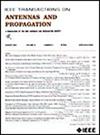宽带紧耦合阵列中一种有效的耦合补偿波束合成方法
IF 4.6
1区 计算机科学
Q1 ENGINEERING, ELECTRICAL & ELECTRONIC
引用次数: 0
摘要
宽带紧密耦合阵列(WTCAs)是现代先进通信系统的重要组成部分。然而,不可避免的相互耦合将导致严重的光束劣化问题和沉重的计算成本。本文介绍了一种具有耦合表征和补偿功能的高效光束合成方法。其中,互耦通过广义互阻抗用模态激励系数(MECs)表示,该方法在宽频带内有效地获得了全波部分单元等效电路方法。值得注意的是,与传统的全波分析方法相比,这种混合方法在实现波束方向图计算方面具有鲁棒性。随后,提出了改进的激励因子(MEF)来补偿耦合引起的波束图劣化。此外,采用频率相关的串联结构实现了wtca的实时波束合成。基于MEF和串联结构,该方法在解决波束劣化和实时波束合成问题方面表现出优异的性能。最后,通过数值算例全面论证了该框架的通用性和有效性。本文章由计算机程序翻译,如有差异,请以英文原文为准。
An Efficient Beam Synthesis Method With Coupling Compensation in Wideband Tightly Coupled Arrays
Wideband tightly coupled arrays (WTCAs) are essential components of modern advanced communication systems. However, the inevitable mutual coupling will lead to severe beam deterioration problems and heavy computational costs. This article introduces a notable and efficient beam synthesis methodology for WTCAs with coupling characterization and compensation. Specifically, the mutual coupling is represented by the modal excitation coefficients (MECs) via the generalized mutual impedance, which is efficiently obtained by the proposed full-wave partial element equivalent circuit method within a wide frequency band. Notably, this hybrid method demonstrates robustness in achieving beampattern calculation compared to traditional full-wave analysis methods. Subsequently, the modified excitation factor (MEF) is proposed to compensate the beampattern deterioration caused by coupling. Furthermore, a frequency-dependent tandem architecture is employed to enable real-time beam synthesis for WTCAs. Based on the MEF and tandem architecture, the proposed methodology shows excellent performance to address the challenges of beam deterioration and real-time beam synthesis. Finally, the versatility and efficiency of the proposed framework are comprehensively demonstrated through some numerical examples.
求助全文
通过发布文献求助,成功后即可免费获取论文全文。
去求助
来源期刊
CiteScore
10.40
自引率
28.10%
发文量
968
审稿时长
4.7 months
期刊介绍:
IEEE Transactions on Antennas and Propagation includes theoretical and experimental advances in antennas, including design and development, and in the propagation of electromagnetic waves, including scattering, diffraction, and interaction with continuous media; and applications pertaining to antennas and propagation, such as remote sensing, applied optics, and millimeter and submillimeter wave techniques

 求助内容:
求助内容: 应助结果提醒方式:
应助结果提醒方式:


